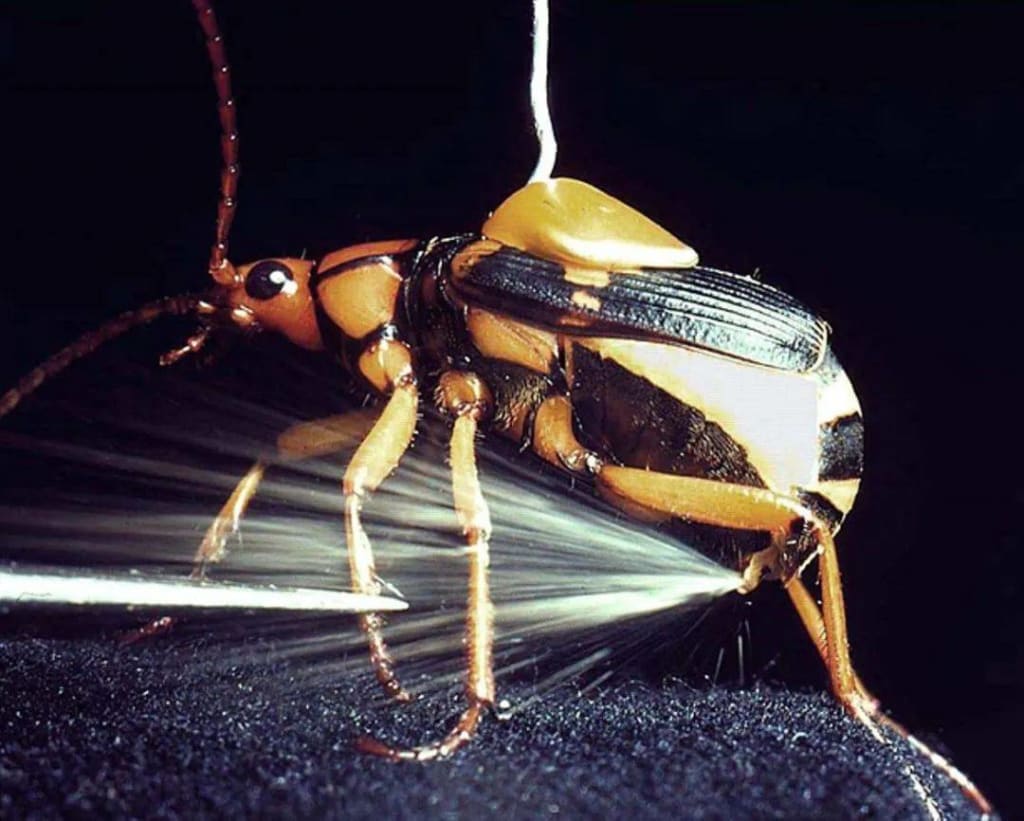The tail frame has a "barrel" that sprays 100°C poisonous mist. How did the 2 cm long beetle do it?
The tail frame has a "barrel", a beetle that sprays 100°C poisonous mist

One day in 1955, Thomas Eisner, known as the "Father of Chemical Ecology" by the world, found a common small beetle in the wild in Massachusetts, USA, so he reached out to grab it and wanted to study it carefully. The result was unexpected. The tail of the beetle suddenly exploded and sprayed a high-temperature toxic spray. Eisner burned his fingers and smelled a disgusting odor.
Out of curiosity, Eisner brought this strange bug back to the laboratory, and he soon found that the little beetle was very special, with a "barrel" on the tail frame, and when it was stimulated, it fired "gas bombs" to attack the enemy , After a loud explosion, the tail "barrel" sprays a 100 ℃ toxic spray outward. The small beetle is only 2 cm in length, but the range can reach several meters.
The little beetles are named Bombardier beetles, which translates to "bombardier beetles" in Chinese. In my country, Bombardier beetles are also very common, and can be seen in Sichuan, Guangxi, Guangdong, Fujian, Taiwan, Jiangxi, Guizhou, and other provinces. The Chinese name is "Qibujia", and some people call it "fart bug" because The spray that comes out smells bad.
The body of the fart bug is less than two centimeters in length, with a yellowish-brown head and black longitudinal spots in the middle. Its appearance is similar to that of most small beetles, and there is nothing special about it. It looks very much like frogs, mantises, and toads. Eat small insects, but when they catch or swallow them, they will surely regret it.
After the fart bug feels the stimulation, it can point the tail "barrel" at the enemy in a very short time, producing a loud noise and shooting a 100 ℃ poisonous spray with a stench, just like a "poison gas bomb", the range can even reach the body length 300 times that of a 2 cm long fart bug, the venom can splash 6 meters away, so it is quite dangerous to catch the fart bug with your hands.
Some footage showed that the mantis grabbed the fart bug for 0.1 seconds, and the fart bug launched a counterattack, aiming its tail at the mantis and spraying poisonous spray at high speed. Smelly and hot because the green forearms turned black. There is also footage showing a toad swallowing the fart bug, only to spit it out in a blink of an eye, showing a distressed expression.
Many friends claim to have been poisoned by fart bugs, and they still remember it fresh. Some netizens said that when I was a child, I caught fart bugs by the side of the reservoir. , but no burns occurred. Some netizens said that when I was a child, my arm was scalded by a fart bug once, and there are still scars.
On earth, poisonous animals are very common, but the animals that produce instantaneous high temperature are probably only fart bugs. How did the 2 cm long beetle do it? The study found that the fart bug spray is produced by the reaction between the compounds quinol and hydrogen peroxide. At first, they were stored in the fart bug's stomach. Once in danger, the fart bug will violently contract the tail muscles, allowing these two substances meet.
The molecular formula of hydrogen peroxide is H2O2, and the molecular formula of diphenol is C6H4(OH)2. After the chemical reaction of these two elements, benzoquinone is formed. The molecular formula of benzoquinone is C6H4O2. The chemical reaction equation is: C6H4(OH)2+H2O2= C6H4O2+2H2O.
Benzoquinone is a golden yellow prismatic crystal with a pungent odor, soluble in hot water, with a melting point of 115.7°C, with strong volatility, which can corrode the skin, cause corneal ulcers, and cloudy lens of the eye. It can lead to necrosis of skin tissue, so it is very toxic. When encountering fart bugs, you must pay attention to protecting your eyes, because it is the most vulnerable organ.
The chemical reaction between quinone and hydrogen peroxide is fast enough. In order to make the chemical reaction more intense, the fart bugs secrete catalytic enzymes, so that C6H4(OH)2 and H2O2 can be directly decomposed into hydrogen and benzoquinone. The chemical formula is: C6H4(OH)2=C6H4O2+H2, 2H2O2=2H2O+O2, the process intensifies the reaction speed and releases a lot of heat.
The researchers' measurements showed that the toxic mist can reach temperatures as high as 100°C, allowing the mixture to reach the boiling point of water. The pressure builds up, forcing the quinone and hydrogen peroxide storage chambers to close, forcing benzoquinone-containing compounds from the exhaust valve violently. It expelled with a loud thud, forming a poisonous spray.
In order to aim at the target, the fart worm quickly turns the tail "barrel" when necessary, which can rotate 270°. After aiming at the target, the poisonous spray is ejected at a rate of about 500 pulses per second, 100% hitting the target, and the bullet is not missed. . Aim at the target, let the two substances react chemically and secrete catalytic enzymes, and this series of actions are all completed within 1 second.
It takes a long time to prepare after each round of the anti-aircraft artillery, but the fart bug can continuously fire like a machine gun, but the "gas bomb" of the fart bug is not infinite, after 20 shots, it will be used up" Cannonballs”, it takes almost 20 hours to complete the replenishment. During this period, there is no “gas bomb” for self-defense, which is extremely dangerous for fart bugs.
In short, if you encounter this beetle in the future, don't grab it with your hands, it is very dangerous.
About the Creator
dardani lennon
The question mark is the key to any science
Enjoyed the story? Support the Creator.
Subscribe for free to receive all their stories in your feed. You could also pledge your support or give them a one-off tip, letting them know you appreciate their work.






Comments
There are no comments for this story
Be the first to respond and start the conversation.